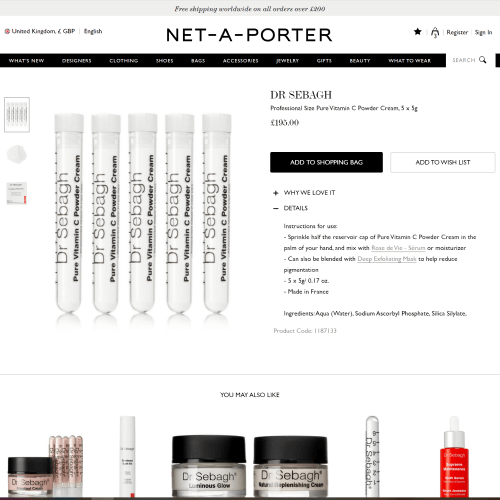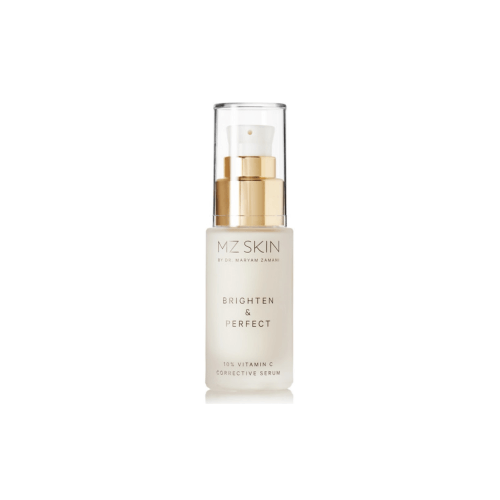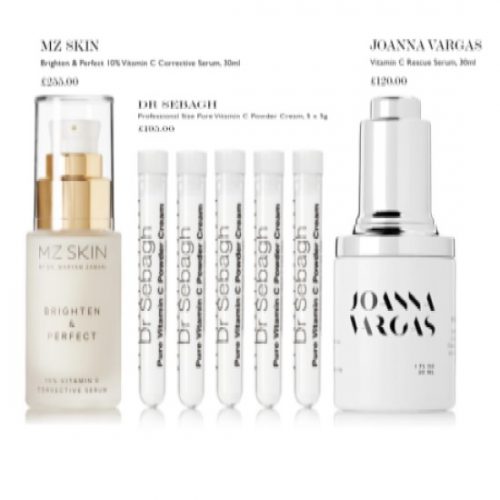You and many researchers are asking the same question: if I have a ton of Vitamin C in my diet, is there any point to a topical treatment? (A topical treatment is a fancy phrase for a face serum, face oil or cream).
I get it – the eye watering prices of Vitamin C serums are enough to put anyone off….Seriously, Dr. Sebagh GBP 195 for Vitamin C powder?!?

My view: you should unequivocally use a Vitamin C topical treatment EVERY DAY
And the only purpose of today’s blog is to convince you to use Vitamin C serums. (FYI Vitamin C here refers to L-Ascorbic Acid only – in forthcoming blogs, you’ll see why the difference is critical).
Vitamin C in our skin
Vitamin C has numerous skincare benefits (anti-oxidant, promotes collagen synthesis and supports long-term collagen and is a skin lightener).
However, its also notoriously unstable – its a water soluble vitamin, rapidly oxidises in water, is only stable at low pHs, hates the heat – and you get the gist.
While uptake of Vitamin C from your diet can be as high as 60% – 90%, by the time this unstable compound “travels” from the gut (intestines) to the topmost layer of the skin, VERY LITTLE Vitamin C in fact remains in the skin.
(The layers of the skin include the epidermis and dermis. The EPIDERMIS is top layer of our skin and shows the first signs of ageing and the DERMIS is the layer right below it. The dermis houses collagen, which gives our skin its structure and resilience.)
Can topical application increase Vitamin C content?
Yes.
The topical route can and DOES increase Vitamin C levels in our skin.
Scientists have demonstrated that on applying an active formulation of topical antioxidants (not just Vitamin C) to the skin:
“(1) The skin attains far higher levels of each antioxidant that can be achieved by only taking these vitamins orally
The level of Vitamin C attained in the skin by topical application is 20 – 40 times than that achievable with oral Vitamin C
(2) Topical application arms the skin with a reservoir of antioxidants that cannot be washed or rubbed off, a protection which stays in the skin for SEVERAL DAYS after application”
As our bodies are terrible at storing excess Vitamin C consumed through our diet, this is great news!
What does Topical Vitamin C do for the skin?
A double blind placebo study answers this question.
This study used 10 patients that already had photodamaged skin and applied a 10% Vitamin C formulation with 7% Tetrahexdecyl Ascorbate to only half of the patients’ faces.
After 12 weeks, the authors found:
- A visible and statistically significant difference in facial wrinkles: the average improvement in wrinkles was about 25%.
- No improvement in hyper-pigmentation (although, other studies have shown this).
- Improved levels of hydration in the skin.
- The clinical improvement in wrinkles correlated with biopsy evidence of NEW COLLAGEN formation.
Yes, you read that correctly: NEW COLLAGEN FORMATION IN PHOTODAMAGED SKIN.
We are not done with the studies…
A significant improvement in furrows on skin histology and clinical appearance was seen in another study (using 5% topical Vitamin C in a double blind study over 6 months).
Why do MZ Skin charge an arm and a leg for their product?

Our skin the fantastic barrier and Vitamin C that fickle, famous diva
Vitamin C – or in its bioactive form – L-Ascorbic Acid – when its in vitro (inside cells), does the job of collagen synthesis, skin lightening and so on.
It’s getting it in vitro that’s the problem.
Vitamin C is a water soluble and its repelled by the physical barrier of the epidermal cells. Its only when pH levels are <4 and Vitamin C is present as Ascorbic Acid that some penetration occurs.
The devil is in the detail
Any Vitamin C product to be effective must ideally be stable when applied and then be able to enter our epidermis and dermis.
This is a massive cosmetic formulation challenge and honestly, you and I pay a premium for those formulations that manufacturers – through their patents or data – are telling us work.
Closing remarks
I don’t believe in paying the equivalent of any country’s GDP for any serum. Nor should you.
But I hope you are convinced that a topical Vitamin C treatment (serum usually) is an anti-aging solution for all women, especially those that have photodamaged skin.
My next few blogs will revolve Vitamin C, so strap in. If you have any queries or comments then please drop me a line at email@happyskindays.com
______________________
Sources:
Humbert, P, Haftek M, Creidi P, Lapière C, Nusgens B, Richard A, Schmitt D, Rougier A, Zahouani Hassan, Topical ascorbic acid on photoaged skin. Clinical, topographical and ultrastructural evaluation: double-blind study vs. placebo, Journal of Experimental Dermatology, Volume 12, Issue 237-244
Lin JY, Selim MA, Shea CR, et al. UV photoprotection by combination topical antioxidants vitamin C and vitamin E. J Am Acad Dermatol. 2003;48:866–874. [PubMed] [Google Scholar]
Bissett DL, Chatterjee R, Hannon DP. Photoprotective effect of superoxide-scavenging antioxidants against ultraviolet radiation-induced chronic skin damage in the hairless mouse. Photodermatol Photoimmunol Photomed. 1990;7:56–62. [PubMed] [Google Scholar]
Fitzpatrick RE, Rostan EF. Double-blind, half-face study comparing topical vitamin C and vehicle for rejuvenation of photodamage. Dermatol Surg. 2002;28(3):231–236. [PubMed] [Google Scholar]
McArdle F, Rhodes LE, Parslew R, Jack CI, Friedmann PS, Jackson MJ. UVR-induced oxidative stress in human skin in vivo: effects of oral vitamin C supplementation. Free Radic Biol Med. 2002;33(10):1355–1362. [PubMed] [Google Scholar]
Lin FH, Lin JY, Gupta RD, et al. Ferulic acid stabilizes a solution of vitamins C and E and doubles its photoprotection of skin. J Invest Dermatol. 2005;125:826–832. [PubMed] [Google Scholar]
Austria R, Semenzato A, Bettero A. Stability of vitamin C derivatives in solution and topical formulations. J Pharm Biomed Anal. 1997;15(6):795–801. [PubMed] [Google Scholar]
Lee S, Lee J, Choi YW. Skin permeation enhancement of Ascorbyl palmitate by lipohydro gel formulation and electrical assistance. Bio Pharma Bull. 2007;30:393–396. [PubMed] [Google Scholar]
Pinnell SR, Yang H, Omar M, et al. Topical L-ascorbic acid: percutaneous absorption studies. Dermatol Surg. 2001;27(2):137–142
https://howtospendit.ft.com/womens-style/203730-vitamin-c-skincare-s-new-wonder-ingredient
